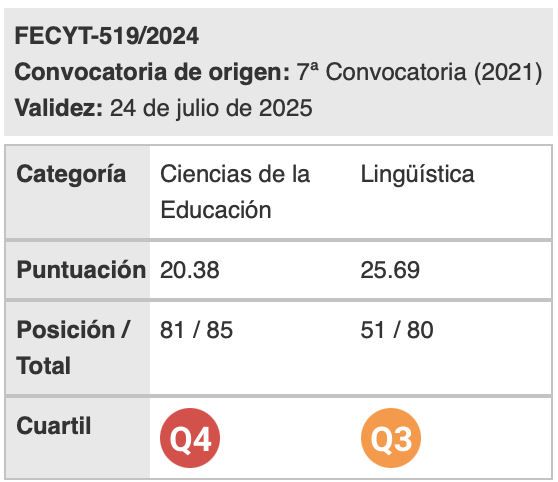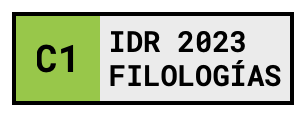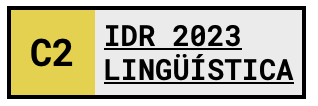The lexical approach: collocability, fluency and implications for teaching
Palabras clave:
lexical approach, collocations, formulaic language, noticing, fluencyResumen
The lexical approach identifies lexis as the basis of language and focuses on the principle that language consists of grammaticalised lexis. in second language acquisition, over the past few years, this approach has generated great interest as an alternative to traditional grammar-based teaching methods. From a psycholinguistic point of view, the lexical approach consists of the capacity of understanding and producing lexical phrases as non-analysed entities (chunks). A growing body of literature concerning spoken fluency is in favour of integrating automaticity and formulaic language units into classroom practice. in line with the latest theories on SlA, we recommend the inclusion of a language awareness component as an integral part of this approach. The purpose is to induce what Schmidt (1990) calls noticing, i.e., registering forms in the input so as to store them in memory. This paper, which is in keeping with the interuniversity Research Project “Evidentiality in a multidisciplinary corpus of English research papers” of the University of las Palmas de Gran Canaria, provides a theoretical overview on the research of this approach taking into account both the methodological foundations on the subject and its pedagogical implications for SLA.
Descargas
Citas
Aitchison, J. (1996). Words in the mind- an introduction to the mental lexicon.
Oxford an New York: Blackswell Publishers ltd.
Chambers, F. (1998) What do we mean by fluency? System, 25(4), 535-544.
Cortina, B. (2009) Una propuesta didáctica para la mejora de la competencia conversacional de una LE mediante secuencias formulaicas. Didáctica, Lengua y Literatura 21, 99-115.
Deignan, A. et al. (1998). Lexis. Centre for English Studies. Birmingham: Uni- versity of Birmingham.
Ellis, N. (1997). Vocabulary acquisition, word structure, collocation, word-class, and mean- ing. Cambridge: Cambridge University Press.
Firth, J. R. (1951). 1957b Modes meaning. in Papers in linguistics. OXFORd Uni- versity Press. pp. 190-215.
Jakobson, R. (1959). lingüística y poética. En: Ensayos de Ligüística General, 347- 395 Barcelona: Ariel.
Lewis, M. (1993). The lexical approach: the state of ELT and the way forward. Hove, England: language Teaching Publicactions.
Lewis, M. (2000) language in the lexical approach. in teaching collocation: further developments in the Lexical Approach, Michael lewis (ed.) pp. 126-154. Hove: language teaching publications.
McIntosh, A. (1961). Patterns and ranges. Language 37: Harper and Row, New York. pp. 325-327.
Miller, J., and R. Weinert (1998). Spontaneous spoken language: syntax and discourse. Oxford: Oxford Clarendom Press.
Moon, R. (1997). Vocabulary connections: multi-word items in English. Cambridge: Cambridge University Press.
Moras, S. (2001). Teaching vocabulary to advanced students: a lexical approach. Karen’s Lingüistics Issues. July, 2001.
Moudraia, O. (2001). lexical Approach to Second language Teaching. www.cal.org/resources/digest/0102lexical.html
Nattinger, and DeCarrico (1992). Lexical phrases and language teaching. Oxford: Oxford University Press.
Newmark, P. (1988). A text book of translation. london: Prentice Hall international. Sinclair, J. (1991). Corpus, conocordance, collocation. Oxford: Oxford University
Press.
Schmidt, R. W. (1990). The role of consciousness in second language learning.
Applied linguistics, 11, 206-226.
Schmitt, N. (2000) Key concepts in ElT: lexical Chunks. ELT Journal 54 (4),
-401.
Thornbury, S. (1998). The lexical approach: a journey without maps? MET 7/4.
Tomlinson, B. (2003). Frameworks for material development. in B. Tomlinson (ed.) Developing materials for language teaching. (pp. 107-129). london: Continuum.
Trimble, L. (1985). English for science and technology. Cambridge University Press.
Willis, D. (1990). The lexical syllabus. Collins ElT.
Willis, D. (1997). Syllabus design and the pedagogic corpus. Vocabulary learning in a foreign language. Triangle 16. ENS Editions.
Wood, D. (2001). in search of fluency: What is it and how can we teach it? The Canadian modern language review 57/4, 573-589.
Wray, A. (2002). Formulaic language and the lexicon. Cambridge. Cambridge University Press.
Wright, B. (2001). Word association and second language learners’ responses. Centre for English language studies. Birmingham: University of Birmingham.
Descargas
Publicado
Cómo citar
Número
Sección
Licencia
Aquellos autores/as que tengan publicaciones con esta revista, aceptan los términos siguientes:
- Los autores/as conservarán sus derechos de autor y garantizarán a la revista el derecho de primera publicación de su obra, el cuál estará simultáneamente sujeto a la Licencia de reconocimiento de Creative Commons que permite a terceros compartir la obra siempre que se indique su autor y su primera publicación esta revista.
- Los autores/as podrán adoptar otros acuerdos de licencia no exclusiva de distribución de la versión de la obra publicada (p. ej.: depositarla en un archivo telemático institucional o publicarla en un volumen monográfico) siempre que se indique la publicación inicial en esta revista.
- Se permite y recomienda a los autores/as difundir su obra a través de Internet (p. ej.: en archivos telemáticos institucionales o en su página web) antes y durante el proceso de envío, lo cual puede producir intercambios interesantes y aumentar las citas de la obra publicada. (Véase El efecto del acceso abierto).

Revista de Lenguas para fines específicos is licensed under a Creative Commons Reconocimiento-NoComercial-SinObraDerivada 4.0 Internacional License.






















